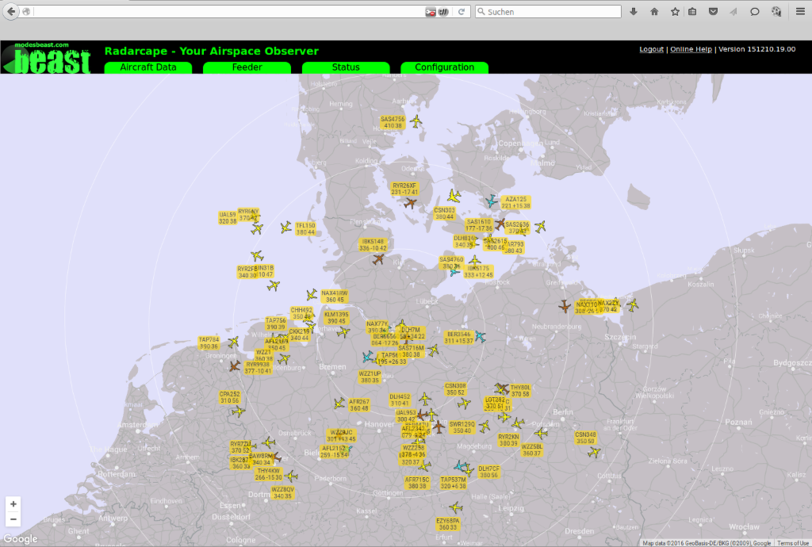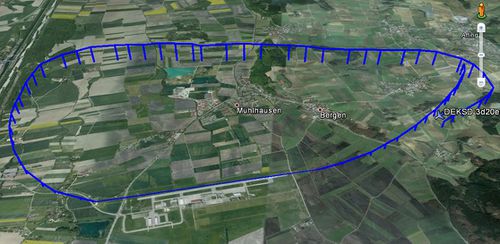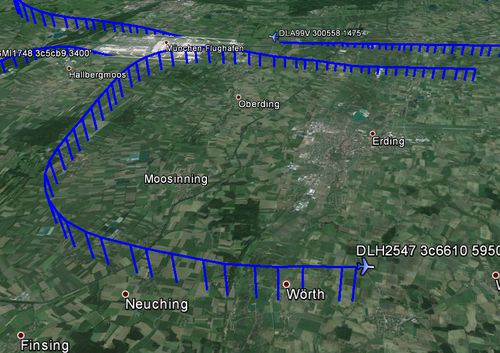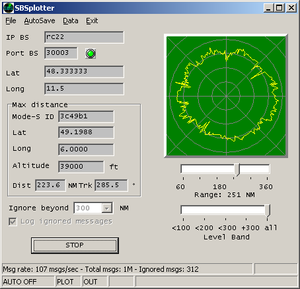Radarcape:Software Features
Radarcape Software Features
The Radarcape provides output of data in several levels:
- true raw data
- decoded data on a per frame basis (e.g. Port 30003)
- decoded data on summary basis (e.g. aircraftlist.json, deltadb.txt)
- web browser support (aircraft list, 2D map)
- 3D output (live KML data)
Web Based Aircraft Table
A list of received aircraft positions can be fetched via a build-in webserver. This list can be sorted ascending and descending in each column by simply clicking on the arrows. The distances is automatically calculated from your GPS coordinates.

Time (hh:mm:ss:ns) => Time of last message received from the aircraft
ICAO => 6 digit ICAO hex ID unique identification of aircraft
Flight => the flight identifier as it is transmitted from the aircraft itself
Lon => Longitude
Lat => Latitude
GndAir => Aircraft is on ground (identified with GND bit or DF-18 messages)
Alt => Altitiude (feet) @ 1013 mb
Speed => currently km/h but will become configurable to knots in next release
Heading => Direction that the aircraft is travelling to
Cat => Cat A0..C5 are transmitted by aircraft in Mode-S messages
Orig => from database, you need to perform Maintenance -> Update flight routes database
Destin => from database, you need to perform Maintenance -> Update flight routes database
Oper => from database, you need to perform Maintenance -> Update base station database
Type => from database, you need to perform Maintenance -> Update base station database
Reg => from database, you need to perform Maintenance -> Update base station database
Squawk => Squawk code as it is transmitted by aircraft in Mode-S messages
Country => Country that is indicated through the upper bits in the ICAO hex id
Distance => Distance to the observer if its Lat, Lon is either valid by manual entry in configuration or determined by GPS
Trust => Number of highly trustable DF-11 or DF-17/18 messages per aircraft. Used to desinguish ghosts, as true aircraft quickly raise this number while ghosts stay at 1
Track Size => Length of the track in 3D display.
2D Display
All received aircrafts with a known position are displayed on a 2D map on any web browser.
Red aircrafts are such that are located with a Radarcape MLAT trial version.

3D Data KML/KMZ Output
Google Earth can be attached to the Radarcape via KML/KMZ files.

An aircraft over Augsburg Airport

Other Web Server Services
- index.html provides a menu of all functions
- deltadb.html outputs a comma separated list of all changes in the internal aircraft list since the last call or a specified time. This is an efficient replacement of port 30003 functionalities
- gps.html informs about the status of the GPS clock
- connectionlist.html contains a history of events on the internal TCP servers
- aircraftlist.json contains the whole internal aircraft database (similar to the table in WEB GUI) in JSON format
Data Streaming to Network (TCP) / Prefiltering / Local CRC Check
The TCP streamed data will be prefiltered for CRC correctness of not directly CRC checkable frames. So the network load is lower than with the pure raw data stream. A port will be provided that streams out only DF-17 (and probably also DF-11) frames, so with least network load anyone else even behind a low speed network can have an overview of what's going around.
- TCP port 10002: This is a mirror of the data as it comes from the FPGA, DF-11, DF-17 and DF-18 are CRC-checked. Includes Mode-A/C data with respect to the setting in the FPGA (DIP switch). This interface may even be AVR format as long as the supplied FPGA firmware supports AVR format, but please note that the Radarcape's high level linux SW may not be able to process AVR format correctly and with all features.
- TCP port 10003: Binary formatted raw data with all Modes-S data formats CRC-prechecked (eleminiates transmission of the erroneous frames, reduces load on the transmission path). All data from the FPGA is disassembled into messages and verfied if correct. In case that, the frame is converted into the binary output format and transmitted over TCP. Includes Mode-A/C data with respect to the setting in the FPGA (DIP switch).
- TCP port 10004: Binary formatted raw data, pre-checked DF-11, DF-17 and DF-18 only: minimum load for the transmission path but contains most information. No Mode-A/C data.
- TCP port 10005: Binary formatted raw data, all raw data frames of just those aircraft that locally no location (latitude and longitude) is known. For special MLAT purposes. No Mode-A/C data.
The binary and AVR data formats are equal to the ones from the Mode-S Beast and described in the section Mode-S_Beast:Data_Output_Formats
USB Serial Port Data Access
The Radarcape supports one selectable data stream out of following sources on a virtual serial port via the back side USB port:
- Raw FGPA data - including Mode-A/C data
- CRC pre-checked Mode-S with Mode-A/C data
- Mode-S Frame types DF-11, DF-17 and DF-18 only
- Mode-S Frames of all aircraft without a known location
- Port 30003 format
The output can be selected in the configuration dialogue. Due to processor load, it is recommended to keep this feature disabled when not required.
The setting can be changed on the fly and will apply without a Radarcape reset.
PC driver
The interface uses the Linux kernel's USB gadget serial driver. It will create a virtual serial COM port which you can identify in your device manager. As far as known at the moment, only an INF file is necessary in order to install it. This can be downloaded here: link g_serial.inf.
The virtual serial port does not require any baudrate and handshake settings, it will work with any configuration.
Take care that when connecting you will get two serial ports: One that provides access to the Linux console, and the one mentioned within this feature. If you have doubts which one to select, first try the higher number, or use a Putty terminal just to see which one outputs weird binary data (or Port 30003 format if selected). The one that outputs a console screen on 115200 Baud is the wrong one.
Further information can be obtained here:
USB Gadget Kernel Documentation
Some usage and driver hints - this is where the INF file comes from.
Restrictions
- Currently the serial interface worked with Putty and an test application on Windows. It did not work with Planeplotter under XP, so don't blame me at the moment.
- Note that even when a Radarcape receives power through the back side USB, you anyway need to connect the external +5V for the receiver and decoder to operate.
Also note that when powering on, USB must not be connected first before external +5V, as then the Radarcape will power on with low CPU clock settings.
Port 30003 Server
Port 30003 style output (e.g., SBS Plotter) can be provided standalone and without need of a PC application.
The Port 30003 data format is described on this web page
The date in Port 30003 messages is always the Linux system date.
The timestamp instead is a GPS timestamp when the config is set to GPS timestamps and system time when the Radarcape operates in legacy 12MHz timstamp mode.
Due to the low efficiency and high processor load caused by this protocol, please do not use Port 30003 unless really necessary.
A better way of getting about the same data is the deltadb web page.
NTP Stratum 1 Normal
The Radarcape can be used as NTP source for correct time setting. For example Planplotter requires such for its own Multilateration.
This currently is not yet installed on the Radarcape.

